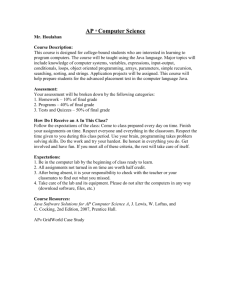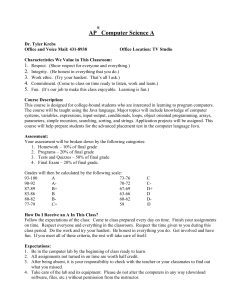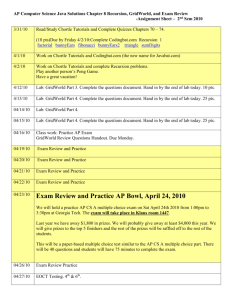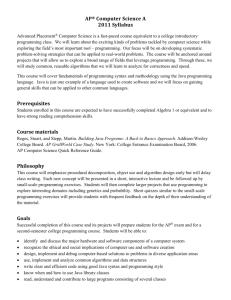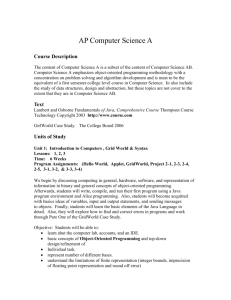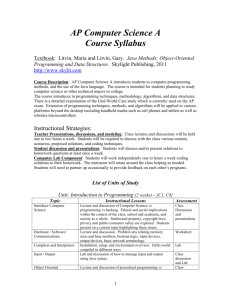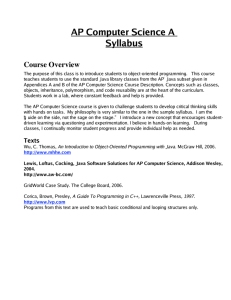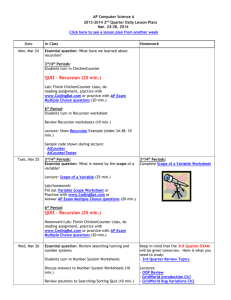AP CompSci Summer Assignment SY 2014
advertisement
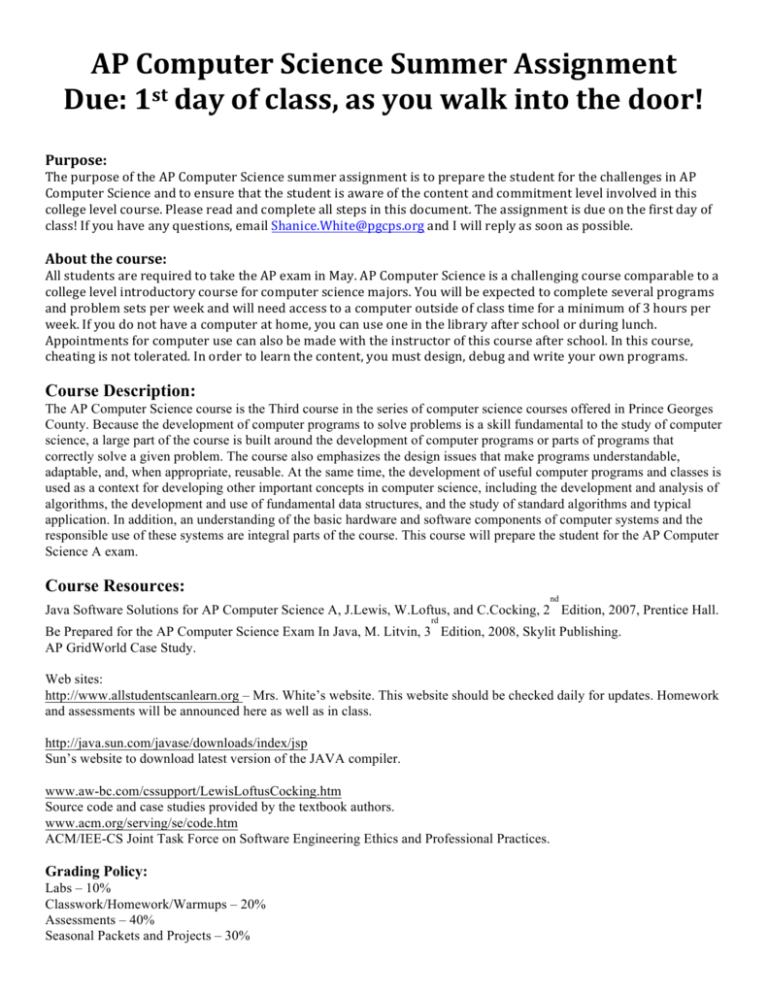
AP Computer Science Summer Assignment Due: 1st day of class, as you walk into the door! Purpose: The purpose of the AP Computer Science summer assignment is to prepare the student for the challenges in AP Computer Science and to ensure that the student is aware of the content and commitment level involved in this college level course. Please read and complete all steps in this document. The assignment is due on the first day of class! If you have any questions, email Shanice.White@pgcps.org and I will reply as soon as possible. About the course: All students are required to take the AP exam in May. AP Computer Science is a challenging course comparable to a college level introductory course for computer science majors. You will be expected to complete several programs and problem sets per week and will need access to a computer outside of class time for a minimum of 3 hours per week. If you do not have a computer at home, you can use one in the library after school or during lunch. Appointments for computer use can also be made with the instructor of this course after school. In this course, cheating is not tolerated. In order to learn the content, you must design, debug and write your own programs. Course Description: The AP Computer Science course is the Third course in the series of computer science courses offered in Prince Georges County. Because the development of computer programs to solve problems is a skill fundamental to the study of computer science, a large part of the course is built around the development of computer programs or parts of programs that correctly solve a given problem. The course also emphasizes the design issues that make programs understandable, adaptable, and, when appropriate, reusable. At the same time, the development of useful computer programs and classes is used as a context for developing other important concepts in computer science, including the development and analysis of algorithms, the development and use of fundamental data structures, and the study of standard algorithms and typical application. In addition, an understanding of the basic hardware and software components of computer systems and the responsible use of these systems are integral parts of the course. This course will prepare the student for the AP Computer Science A exam. Course Resources: nd Java Software Solutions for AP Computer Science A, J.Lewis, W.Loftus, and C.Cocking, 2 Edition, 2007, Prentice Hall. rd Be Prepared for the AP Computer Science Exam In Java, M. Litvin, 3 Edition, 2008, Skylit Publishing. AP GridWorld Case Study. Web sites: http://www.allstudentscanlearn.org – Mrs. White’s website. This website should be checked daily for updates. Homework and assessments will be announced here as well as in class. http://java.sun.com/javase/downloads/index/jsp Sun’s website to download latest version of the JAVA compiler. www.aw-bc.com/cssupport/LewisLoftusCocking.htm Source code and case studies provided by the textbook authors. www.acm.org/serving/se/code.htm ACM/IEE-CS Joint Task Force on Software Engineering Ethics and Professional Practices. Grading Policy: Labs – 10% Classwork/Homework/Warmups – 20% Assessments – 40% Seasonal Packets and Projects – 30% Unit Information: Unit 1: Introduction to Computer Systems & Ethics The student will learn about the components of a computer system, hardware and software. The code of ethics provided by the ACM will be explored. The students will download and install the latest JAVA compiler and the GridWorld Case Study, as well as the support material provided by Lewis,Loftus,Cocking. Unit 2: Key Elements of a Program This unit explores the key elements of a program. The use of primitive data types and the use of pre-defined objects are introduced. Students are also introduced to design techniques including pseudocode, flowcharting, and structure charts. Students create their first programs. Students will also work through Part One of the GridWorld Case Study. Unit 3: Flow Control Structures This unit covers the two basic flow control structures. Students will learn to use both selection and repetition statements to control the flow through a program. The students will also learn about boolean expressions and truth tables. Unit 4: Writing Classes This unit covers how to create a class. Proper method structure and class composition is enforced. This unit also explores interfaces and how to use them to create a class. Unit 5: Arrays This unit covers the design and use of one dimensional arrays, including using arrays as parameters, and searching and sorting arrays. The use of the ArrayList class and the use of ListIterator will be introduced. Multidimensional arrays will also be explored. Unit 6: Advanced Classes This unit covers the concepts of inheritance, class hierarchies, and polymorphism. Abstract classes will be explored. Polymorphism will be explored using both inheritance and interfaces. Unit 7: Recursion This unit covers recursion, including what recursion is and when it should be used. Concepts of recursion in searching and sorting are explored. Unit 8: GridWorld Case Study Students will complete parts two, three, and four of the GridWorld Case Study. Unit 9: Exam Preparation The students will review materials to prepare for the exam. An exam review book will be used, as well as, previous year’s exams. Unit 10: Final Project Using previously created classes, the student will create a program to solve a specific situational problem. The students may work in a partnership with another student, or work alone. Sample projects: Create the game of 21 using the deck of cards created in Chapter 6 of Lewis,Loftus,Cocking Create the game of dice poker using the die class provided in Chapter 4 of Lewis,Loftus,Cocking. Additional Information: Requirement: Minimum of three hours of computer access a week. Students will have access to the classroom computer lab during class time. Students will also have access to the school computer lab at least 2 days a week after school for up to an hour. Students will be responsible for keeping a log of lab hours and having it signed by the appropriate supervisor. 1. JavaBat.com – Using your required gmail account (created for Research Practicum), sign up for a JavaBat.com account. Remember your password. When you have created your account, add me in preferences to share results with. JavaBat is self contained and you do not need a separate compiler for it. As you complete your code, results will be shared with me in the form of graphs. Your IP address will also be documented as well as the time it took you to complete each assignment. In addition, you will receive instant feedback of your progress. Below, is an example of what you will see when you have created your account. 2. Using JavaBat.com, view MORE under warmup-­‐1, strings-­‐1 and logic-­‐1. An example of what you will see is below. Using the table provided, complete six required programs. Students with last names that begin with A, D, G, J, N, R, X Complete the following: sleepIn diff21 helloName makeOutWord cigarParty firstHalf Students with last names that begin with B, E, H, K, O, T, Y Complete the following: mokeyTrouble parrotTrouble makeAbba extraEnd dateFashion sortaSum Students with last names that begin with C, F, I, L, P, U, Z Complete the following: sumDouble makes10 makeTags firstTwo squirrelPlay alarmClock Students with last names that begin with M, P, Q, S, V, W Complete the following: hasten mixStart helloName firstHalf love6 more20 3. Download and print a copy of the AP Computer science reference manual from my website. This and your required journal are the only items allowed during testing throughout the year. 4. Make sure the following mandatory software applications are installed on the computer you have available for use: Java JDK, GridWorld, jGrasp. 5. Go to http://greenteapress.com/thinkapjava and download thinkapjava.pdf “How to Think Like a Computer Scientist” by Allen B. Downey. Read Chapter 1 “The Way of the Program. 6. Write a summary of Chapter 1 “The Way of the Program.

